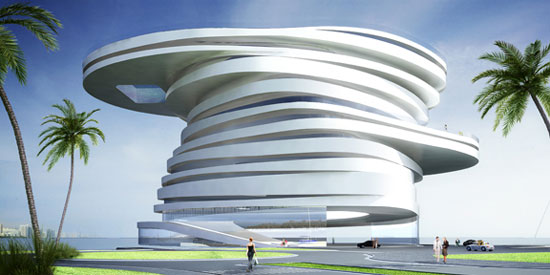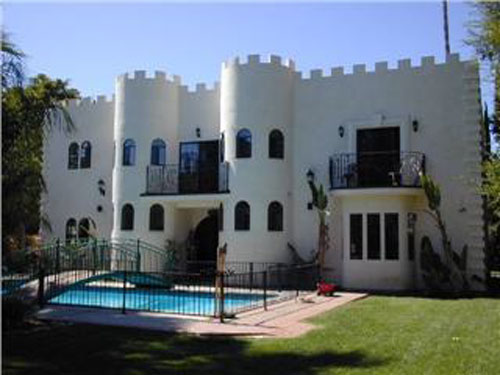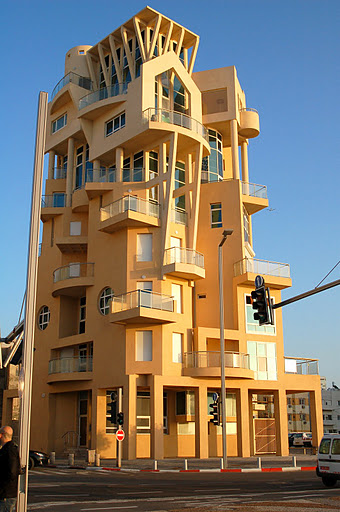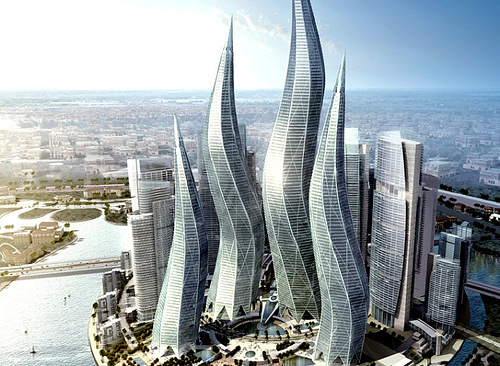Andres Lepik: Moderators of Change - Socially Engaged Architecture
Last Thursday we conquered the pouring rain once again to meet at the Guggenheim Lab in Prenzlauer Berg to hear a talk by Andres Lepik.
Andres Lepik is an art historian, curator, author and speaker on civic engagement in architecture.
His recent book Moderators of Change presents contemporary examples of social engagement in architecture on a global scale and explores various strategies for how design can actively influence under served communities. Andres’ research focuses on three main areas: rural neighborhoods in developing countries, informal cities and new strategies for shrinking cities.
The talk was given in the outdoor presentation area, with 2 English translators and very cool ear-pieces that we put in to listen to his talk while watching the big screens that projected his images. We actually didn't realize that the lecture had already begun and were sort of dawdling around the cafe area so we missed the first 5 minutes or so. Anyways we jumped in at the point where Andres was talking about Corporate Social Responsibility.
Corporate Social Responsibility (CSR) refers to the practice of having a set of ethical processes built into your business model, in an attempt to take into consideration not just shareholders, but 'stakeholders' (anyone who has an interest in your business or whom your business will impact). The environment is one example of a stakeholder.
Andres used the example of McDonald's: The Ronald McDonald foundation provides camps and schools through donations and from part of the profits of eating a big mac. This is sometimes referred to as 'Ethical Consumerism,' where a consumer is given a choice between buying one product or buying a similar product that will directly or indirectly help solve a problem.
Starbucks does this with their Ethos water, Tom's does this with shoes. Almost all of the time the basis of this ethical consumerism is philanthropic: to provide a service for someone else while giving the consumer a sense that they have done something good by purchasing your goods.
One of the criticisms of ethical consumerism is that, as Andres put it, you are f*$%ed if you think there is a positive relationship between your purchase and the well-being of another person or situation. The water you buy at Starbucks comes from somewhere, and maybe money from your purchase goes into a "relief fund" but in all likelihood it is doing nothing to help relieve drought in Africa.
The same with Tom's shoes. You could just give $10 to a foundation directly instead of purchasing the overpriced, somewhat crappily made version that Tom's sells. But Tom's is seen as giving a service: shoes for children. The problem is that this is a service that is not needed. There are plenty of shoes available at the markets in the countries that receive free Tom's shoes. By bringing in free shoes, the Tom's model is undercutting the local trade which ultimately has negative consequences for the locals.
“What’s better? Bestowing free shoes or empowering and engaging locals?”
That touches on a major criticism of foreign aid in general, which is that foreign aid boils down to white people coming in to give solutions to problems that don't exist or that they don't understand.
The point of this segue was to point out that while there is some attempt at 'social responsibility' in the business world, there are no ethical codes for architecture. Architecture has no conscience: if hired to clear out slums to build a luxury hotel, that is what architects will do. There are many cities where the borders between the informal and formal worlds (e.g., slums vs. luxury condos) butt up against each other. There is often a literal wall between these worlds. What can be done to abolish this wall?
Segue again into a very publicized project by Haas & Hahn; Jeroen Koolhaas (the son of Rem Koolhaas) and Dre Urhahn. The project was called Favela Painting and the purported effect was that by painting the facades of favelas in bright colors, it would bring local pride to the neighborhood and teach locals 'professional painting skills.'
Inhabitat: "Brilliant Favela Paintings Energize Neighborhoods!"
Not socially engaged: Haas & Hahn
Andres criticises this project for creating an image of happiness for the New York Times rather than the people who live here. What remains for the people after the photographers leave?
Nothing. There is no real service here, the brightly colored facades exist almost purely to bring smiles to rich Westerners and leave them with a glowing feeling that they have done something positive for this place when in fact they have done nothing.
“Architecture can do more than color the misery.”
SMALL SCALE | BIG CHANGE
Andres introduces a list of criteria to measure so-called ethical projects and evaluate if they will have a long term positive impact:
1. Local Value
Refers to the use of local knowledge and insight into the conditions and social context of the project, and how it will impact the area financially.
2. Engagement Value
Architects are used to waiting for people to come to them with commissions but it doesn't have to be like that, we can look for our own projects that are closely involved with our communities.
3. Social Value
What we build is for the users and the workers who make it, not for a theory or an aesthetic ideal in our heads.
4. Strategic Value
Architecture is rooted in the local situation but it has an impact on the work of other practitioners.
5. Design Value
The project fosters aesthetic values.
Lepik then started giving examples of projects that meet these criteria.
1. Primary school in Burkina Faso, by Francis Kere
The entire local society was included in the design and construction of this primary school in Gando. It has an ecological and aesthetic impact that is much stronger than typical foreign aid schools that are made from concrete block and corrugated metal. This school reflects the local building culture of compressed earthen blocks that community helped to make. The roof is raised rather than enclosed, which brings in passive air flow and indirect light. The roof prevents sun radiation, so the building is the coolest place in the community. In the evening they use it as a meeting place.
It is one of the most successful schools in the country, the students do exceptionally well because all the best teachers want to teach at this school. This is because of the well-considered ventillation and passive cooling techniques. It is also aesthetically very beautiful inside, with great light conditions.
In the typical foreign aid schools, if it is 40 degrees Celcius outside it is 50 inside. That is because there are no breaks between the corrugated metal roofs and the concrete blocks. It creates a terrible interior atmosphere. They also have a problem building the schools because as soon as they deliver the materials to the site, people will steal them for their own homes. There is no sense of ownership or local community in a pre-packaged school kit. They are far less successful.
2. The Inner City Arts Project - Skidrow, LA, by Michael Maltzan.
Every brown building in this image is part of skidrow, where there are 4-5000 homeless people and the poverty rate is 40%. In California they abolished arts education in the public schools to save money, so this arts center was initiated by Michael Maltzan, formerly of Frank Gehry Architects, to ensure that youths still have the opportunity to get an arts education.
This is a private center (meaning, not funded by the government) that is free for all youths from all over.
Initially the arts center was based in a garage building, and over the last 15 years it has expanded to all the white area you see today. The entire block has been developed and 40, 000 school age students have the chance to get arts lessons. The project has had an impact on the entire community and you can tell that the community accepts it, as there is absolutely no graffiti.
After the success of the arts center, Maltzan joined with the skidrow building trust to build homes for the homeless. Not just a homeless shelter, but a place where the homeless can live and keep an address. There is an inner courtyard with a communal kitchen, bathroom, and meeting rooms. Because these projects are based on inclusiveness with the local community, they are successful where other attempts at design have failed.
3. a) Metro Cable for the Favelas of Caracas, by Urban Think Tank
Favelas of Caracas, Venuzuela
Favelas / slums are one of the most prevalent housing typologies on earth. They are prime example of 'informal' housing - unplanned and unco-ordinated with a main city plan, sewage, or electrical grid. One of the main issues with favelas is that they are so isolated from important services such as education and healthcare, and that creates a pretty grim future. There are no planned roads or access points to get to the main city.
Urban Think Tank, a New York based firm, worked with 2 local architects to build a funicular system. The idea was to give access to the city without having to walk or drive. People who live here can now access schools and hospitals and so the metro-cable cars are a vehicle for social change.
3. b) Quinto Monroy Housing - Iquique Chile, Elemental Architects
This project by Elemental provides residents with informal structures completed to 50%. The residents finish the structures themselves. The buildings are built for $5, 000, given as a loan to the residents. The logic of barrios in Chile is to grow further, and now the vacant gaps are being filled. These houses are an economic investment in the poor, because as they finish their houses (using materials they would be using in barrios anyways), they can rent out a part of their house to help pay off their loan. Once they pay off the loan they own their home and can start businesses there legally.
The whole project scheme works on the principle of assisting the residents out of illegal living, providing capital, and becoming part of a legal economy.
4. Tour Bois-le-Prêtre - Paris, France, Anne La Caton, Jean Philippe Vassal & Frederic Durot.
Outside the ring-road of Paris are the suburbs that no tourist ever visits. These suburbs have been subject to many discussions and plans for how to solve the problems of unemployment, racial tensions, and poor living conditions for the mostly immigrant populations.
One of the most popular techniques for 'solving' the problems involves demolishing Modern period apartment buildings that are seen as impediments to proper social integration. This project takes the opposite approach and says that people have built up social networks within their neighborhoods, and the answer is not to demolish the buildings but to improve them.
The idea behind this tower was to have a dry construction element; to build a shell around the entire building. This shell acts as a double facade, bringing more light and space into the apartments as well as lowering heating costs and allowing the residents to stay in the building the entire time the shell was under construction. Once the shell was constructed, the former outer walls of the apartment building could be removed, giving each resident floor to ceiling views over Paris. The residents had influence in their flats and the government saved a lot of money by not demolishing and rehousing.
5, 6, 7.... I don't have the time to go over every example that Andres talked about. I will provide the links to each instead:
5. Passage 56 - Paris, France, Atelier d'architecture - An unused lot was transformed into a self-sufficient community plot.
6. Penzberg Mosque - Penzberg, Bavaria - A local Imam and local Priest use participatory design to build community support for a multi-functional mosque / religious center.
7. Haushalten e.V. Leipzig - Bringing creative locals together with a building preservation society to renovate and use abandoned buildings.
The closing remarks are that:
“Architects need to do more than just build.”
There needs to be a focused attention on a specific problem or opportunity rather than rebuilding, reselling, or simply demolishing. This focused attention can totally change the community.
Questions from the audience:
1. Why don't government aid societies use Francis Kere's approach of working with the locals to build rather than the concrete boxes they propose now?
The Kere version is a real investment in the community and the people are involved with the whole process rather than just given something. Aid agencies do not have the quality control or the motivation to invest in the local community and to keep costs down they use a 'one-size-fits-all' approach.
2. Is there any similar situation like Haushalten e.V Leipzig in Berlin?
Not yet.
3. How can educators change the way architecture students are educated so that they understand architecture is not just about building iconic museums or fantastic forms?
Some Berlin schools are in touch with Burkina Faso and have done more work there, such as teacher's living quarters and a library. They develop a long term relationship with a place and the people. Schools that do that will have a very good head start in helping their students realise the potential of architecture as a community development tool and not just a path for personal glory.
Rural Studio and Auburn University work directly with the community as a design/build school. Any school that provides the opportunity for design/build workshops as a basis will produce architects that go on to do meaningful projects.
Final Thoughts
I loved this lecture because it showed examples of architecture that is truly admirable, not just pleasant to look at. There are many people in the world who think that "good / interesting architecture" looks like this:




That is, in a way, the point of all this discussion. Architecture has mainly been a rich-person's pursuit, something that is commissioned to serve a stylistic whim and delivered with no question of what effect it has on the surrounding context.
There are many who think the goal of architecture is to do something new and unique, but lack the taste to moderate the aesthetic. You can argue that taste is relative, but you can't argue that any of the images directly above will have any real positive impact on the places they are built. They are simply 'painting over the misery', just like the colorful favela painting project.
To make meaningful places I think the world has to let go of its perception of architecture as a series of showstopping icons that try to one-up each other from year to year. Good architecture is rarely showy, but often beautiful in a way that speaks to the real daily needs of the users.
My hope is that more and more practices arise where placemaking and context is just as important as aesthetic form, where the client is only one voice in a group, and where the community and environment are involved in the whole process rather than 'gifted' a piece of architecture that they may not want, need, or use.






